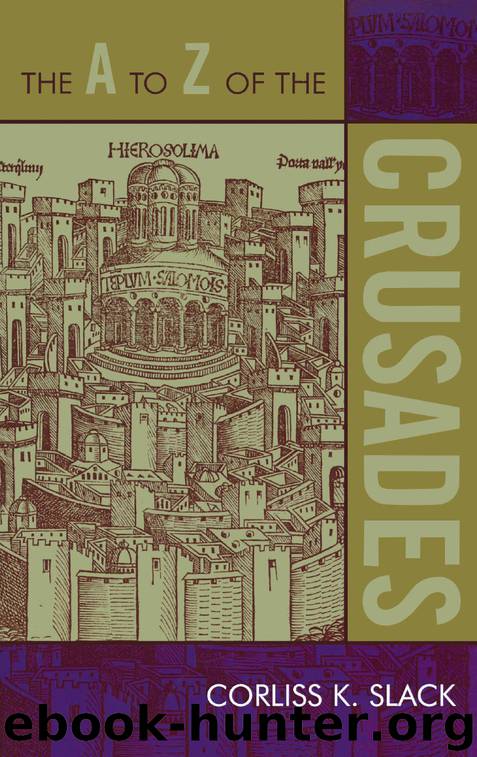The A to Z of the Crusades by Corliss K. Slack

Author:Corliss K. Slack
Language: eng
Format: epub
Publisher: Scarecrow Press
Published: 2003-03-14T16:00:00+00:00
-J-
JACOBITE CHRISTIANS. Jacob Baradaeus (c.500-578) was a peripatetic saint, born near Edessa, who traveled throughout the Byzantine Empire to ordain priests and bishops for the persecuted sect of the Monophysite Christians in Syria. The word Jacobite was used for the Syrian church after a church synod in Nicaea in 787, to distinguish it from other forms of Monophysite belief which developed in Jerusalem, Antioch, Alexandria, and Constantinople after 451. The original disagreement was about the theological definition of the nature of Christ. Attempts to reconcile various definitions failed at the Council of Chalcedon in 451. Persecutions of the Monophysites by emperors of Byzantium resulted in regional churches grouped around the cults and ideas of holy men like Jacob. Pillar saints following the ascetic example of St. Simon Stylites (c.389-459) continued to be found in Syria through the crusade period, and are representatives of Jacobite spirituality.
Like the Copts and Nestorians, the Jacobites were outlawed as schismatics under Greek Orthodox rule. The Nestorians escaped to Persia (Iran) but the Jacobites seem to have been the majority of the inhabitants of Syria before the Arab conquest. After 658 they had the same rights as other Christians under Muslim rule, and were even allowed to do missionary work in Mesopotamia and Iran. They were less easily accepted by the Turks and Crusaders who arrived in the 11th century. European Christians were not at first able to distinguish between Muslim and Christian inhabitants of the Levant, and they were suspicious of even Greek Orthodox believers, but by the early 12th century, they seem to have been at least coexisting with the Jacobite church. Hulagu, Mongol conqueror of Baghdad and Damascus by 1258, also seems to have respected the church’s right to exist, at least after the initial horrors of Mongol conquest. After 1295 Mongol conversion to Islam led to massacres of Jacobite Christians in northern Syria and Mesopotamia. Monasteries and libraries belonging to the churches were lost. The Jacobites continued to exist as a heavily taxed minority under Ottoman rule.
JACQUES DE VITRY. (c.1170-1240). Jacques/James was educated in Paris and ordained a priest in 1210. He served as a regular canon in the church of St. Nicholas of Oignies in the diocese of Liège in 1211-16. In 1213 he preached the Albigensian crusade, and in 1214 was with a party of crusaders at the siege of Toulouse. He then preached the Fifth Crusade and was elected bishop of Acre (r.1216-27). He accompanied the crusade to Damietta and wrote an account of the expedition in letters to Pope Honorius III. By 1228 he had resigned his office in Acre to become auxiliary bishop of Liège. He was made cardinal-bishop of Tusculum in 1228 or 1229. His various writings (sermons, letters, narratives) are an important source of information for the early 13th century.
JAFFA. Jaffa, a commercial port mentioned in both the Old and New Testaments, was critical to supplying the Latin Kingdom and especially crusader Jerusalem after 1099. It became the base for a crusader county and was held by Guy of Lusignan when Saladin conquered the Latin Kingdom in 1187.
Download
This site does not store any files on its server. We only index and link to content provided by other sites. Please contact the content providers to delete copyright contents if any and email us, we'll remove relevant links or contents immediately.
| Africa | Americas |
| Arctic & Antarctica | Asia |
| Australia & Oceania | Europe |
| Middle East | Russia |
| United States | World |
| Ancient Civilizations | Military |
| Historical Study & Educational Resources |
Room 212 by Kate Stewart(4739)
The Crown by Robert Lacey(4573)
Endurance: Shackleton's Incredible Voyage by Alfred Lansing(4507)
The Iron Duke by The Iron Duke(4122)
The Rape of Nanking by Iris Chang(4023)
Killing England by Bill O'Reilly(3898)
Joan of Arc by Mary Gordon(3784)
Say Nothing by Patrick Radden Keefe(3725)
I'll Give You the Sun by Jandy Nelson(3273)
Shadow of Night by Deborah Harkness(3176)
Hitler's Monsters by Eric Kurlander(3164)
Mary, Queen of Scots, and the Murder of Lord Darnley by Alison Weir(3066)
Blood and Sand by Alex Von Tunzelmann(3058)
Darkest Hour by Anthony McCarten(3018)
Margaret Thatcher: The Autobiography by Thatcher Margaret(2971)
Eleanor & Park by Rainbow Rowell(2943)
Red Famine: Stalin's War on Ukraine by Anne Applebaum(2816)
Book of Life by Deborah Harkness(2720)
The One Memory of Flora Banks by Emily Barr(2685)
